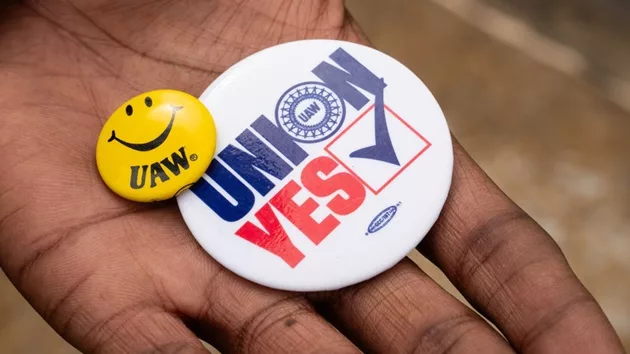(NEW YORK) — Marcelo Candia spends all day teaching a classroom full of 4-year-old children in northern Virginia — then walks across the street to work in a grocery store bakery for four more hours.
It’s the reality faced by so many workers in the child care industry, where low pay and other factors have created a labor crisis exacerbated by the coronavirus pandemic.
“I love what I do,” Candia, a father who is also working toward an associate’s degree, told ABC News. “I come here with a lot of energy. I go out of the school when I’m finished my period here with a boost of energy.”
As the U.S. job market continues to bounce back from the coronavirus pandemic, the child care industry has lagged behind.
The sector has lost about 9.7% of its workforce compared to pre-pandemic levels, or about 102,400 employees between February 2020 and last month, according to the Bureau of Labor Statistics.
‘This is unheard of’
Leslie Spina, who runs five early childhood education centers in Philadelphia, told ABC News she continues to face staffing shortages.”
“We’re about 22% short-staffed right now,” Spina, the executive director of Kinder Academy, said. “This is unheard of.”
At Candia’s center, ACCA Child Development Center in Annandale, Virginia, the shortage of workers has meant fewer kids can receive care.
“I have a couple of classrooms that are not staffed,” Isabel Ballivian, the executive director of ACCA Child Development Center, told ABC News. “Therefore, we don’t have children there.”
Low wages drive staffing shortage, experts say
The most significant factor driving the staffing crisis is low pay for child care workers, according to experts.
A child care worker in the United States made an average of just $13.31 per hour, or $27,680 per year, in 2021, according to the most recent available data from the Bureau of Labor Statistics.
“It’s physically mentally, emotionally hard work, and it’s one of the lowest paid jobs in every single state in the country,” said Lea Austin, the executive director of the Center for the Study of Child Care Employment, at the University of California, Berkeley.
Many day care teachers want to stay in the industry but cannot afford to provide for their own families, educators and center directors told ABC News.
“If I wanted to have kids, if I wanted to get married and kind of go to that next part of my life, it’s just not really possible,” Nicole Lazarte, who leads an infant classroom at ACCA Child Development Center, said. “I could do it, and I’ve seen people do it, but I see them struggle.”
Instead, educators often turn to higher-paying, less stressful jobs in retail and restaurants.
“We’re not paying what Target pays,” Spina said. “We’re not paying what Chick-fil-A pays — because we can’t afford to.”
Many teachers are also drawn to publicly funded K-12 schools, which typically offer better wages, vacation time and other benefits. Center directors say that can lead to a brain drain at day cares as more experienced workers leave.
Reliance on tuition from parents prevents wage increases
Unlike public K-12 schools, which are funded by taxpayer dollars, early childhood centers primarily rely on tuition charged to parents to fund their budgets.
They do also often receive some public assistance, but the amount they get varies widely across states and jurisdictions.
But it’s not nearly enough for so many centers, many of which closed during the pandemic as enrollment lagged.
“We are not going to solve this problem without public intervention and public funding,” Austin said. “It really is the equivalent of trying to fund a public school system through parent fees.”
Ballivian, who runs ACCA Child Development Center, said that raising tuition simply is not an option, with many working-class parents struggling to make ends meet themselves.
“The large majority of the children that we serve come from families that have low income and that are relatively new to the community,” Ballivian told ABC News. “It is imperative that these kids have access to quality care and education, because it’s the one thing that is changing the trajectories of their lives.”
Some daycare centers have fought to retain workers by increasing pay and benefits, but limited financial resources makes doing so difficult.
The center receives some funding from the county and state — and got federal dollars during the pandemic — but, Ballivian said, is still facing an approximately $200,000 deficit for the current fiscal year “because we decided to increase the salaries.”
“There are times when you wake up and think, is it worth it? Should I continue to do this?” she said. “But I know that I am making a difference in the lives of others.”
DC tries supplementing teachers’ incomes
Some jurisdictions, like Washington, D.C., have tried to channel more money to early childhood centers — and teachers.
The D.C. government, which provides various grants to centers themselves, also launched an innovative program this year that supplements educators’ salaries — with payments totaling up to $14,000 per year.
Payments to teachers are part of an array of funding the city spends on early child care, according to Sara Mead, the city’s deputy superintendent of early learning. Residents benefit from free, universal pre-kindergarten; centers receive grants to raise their quality of care; and low-income families receive subsidies to cover child care costs.
Latoria Meyers, who teaches infants and toddlers at Kidspace Child and Family Development Center in Washington, said the additional money from the city has helped her “tremendously.”
“I’m a single mom, so it helped me kind of get back on a financial balance, as far as, like, paying some things off, actually taking my son on a trip finally — his first plane ride,” Meyers told ABC News.
The center where she works provides free child care to families who have experienced homelessness, trauma and abuse. It relies largely on private donations, as well as funding from the city.
Sandra Jackson, the president and CEO of House of Ruth, the organization that runs the center, told ABC News that paying relatively more has helped retain quality workers.
“It’s a no brainer,” Jackson said. “The child care workers, teachers, anyone that comes in contact with children is just as important as our doctors, our lawyers, our Supreme Court justices.”
Parents feel squeeze
Amid the staffing shortages, parents have felt the squeeze as options for care become more limited.
Courtney Tay, a pre-kindergarten teacher in Springfield, Missouri, has spent months searching for a day care space for a daughter she is expecting in December.
“For most of the centers, they don’t have any availability until summer or fall of 2023,” she said. “I’m looking for care when she is three months old, and they’re not going to have any available until she’s about eight or nine months old.”
Tay plans to rely on her mother for help until then.
“I’ve been really surprised by how difficult it is to find a place for her,” Tay said.
Federal reform needed to end crisis, experts say
Experts say reform is needed at the federal level to transform the early childhood education system, attracting workers and making care affordable and accessible.
“The reality is state and local governments can’t do this on our own,” Mead, of the D.C. government, told ABC News. “There are fiscal constraints that we operate under that are different from those of the federal government and so to get really large infusions of funds, it will be necessary to tap the power of federal funds.”
President Joe Biden pushed Congress to approve major investments in child care, including funding for free, universal preschool for all 3- and 4-year-old children nationwide.
But after Republicans in Congress blocked that plan, Biden faced additional resistance from Democratic Sen. Joe Manchin, of West Virginia, and dropped the investments from a later iteration of a domestic spending plan Congress did pass.
Without change, the industry will continue to face job shortages and high rates of staffing turnover, according to Austin, who has studied the U.S. early childhood care system’s workforce extensively.
“If we can’t figure out how to have reform of our early childhood education system that is driven by public dollars,” Austin said, “we’re not going to recover from this crisis.”
Copyright © 2022, ABC Audio. All rights reserved.




